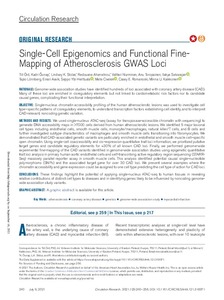Single-Cell Epigenomics and Functional Fine-Mapping of Atherosclerosis GWAS Loci
Ord Tiit; Ounap Kadri; Stolze Lindsey K.; Aherrahrou Redouane; Nurminen Valtteri; Toropainen Anu; Selvarajan Ilakya; Lönnberg Tapio; Aavik Einari; Ylä-Herttuala Seppo; Civelek Mete; Romanoski Casey E.; Kaikkonen Minna U.
https://urn.fi/URN:NBN:fi-fe2021093048927
Tiivistelmä
Rationale: Genome-wide association studies have identified hundreds of loci associated with coronary artery disease (CAD). Many of these loci are enriched in cisregulatory elements but not linked to cardiometabolic risk factors nor to candidate causal genes, complicating their functional interpretation.
Objective: Single-nucleus chromatin accessibility profiling of the human atherosclerotic lesions was used to investigate cell type-specific patterns of cisregulatory elements, to understand transcription factors establishing cell identity, and to interpret CAD-relevant, noncoding genetic variation.
Methods and Results: We used single-nucleus ATAC-seq (assay for transposase-accessible chromatin with sequencing) to generate DNA accessibility maps in >7000 cells derived from human atherosclerotic lesions. We identified 5 major lesional cell types including endothelial cells, smooth muscle cells, monocyte/macrophages, natural killer/T cells, and B cells and further investigated subtype characteristics of macrophages and smooth muscle cells transitioning into fibromyocytes. We demonstrated that CAD-associated genetic variants are particularly enriched in endothelial and smooth muscle cell-specific open chromatin. Using single-cell coaccessibility and cis-expression quantitative trait loci information, we prioritized putative target genes and candidate regulatory elements for approximate to 30% of all known CAD loci. Finally, we performed genome-wide experimental fine-mapping of the CAD variants identified in genome-wide association studies using epigenetic quantitative trait loci analysis in primary human aortic endothelial cells and self-transcribing active regulatory region sequencing (STARR-Seq) massively parallel reporter assay in smooth muscle cells. This analysis identified potential causal single-nucleotide polymorphisms (SNPs) and the associated target gene for over 30 CAD loci. We present several examples where the chromatin accessibility and gene expression could be assigned to one cell type predicting the cell type of action for CAD loci.
Conclusions: These findings highlight the potential of applying single-nucleus ATAC-seq to human tissues in revealing relative contributions of distinct cell types to diseases and in identifying genes likely to be influenced by noncoding genome-wide association study variants.
Kokoelmat
- Rinnakkaistallenteet [27094]
